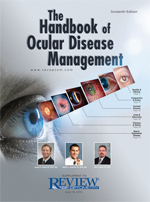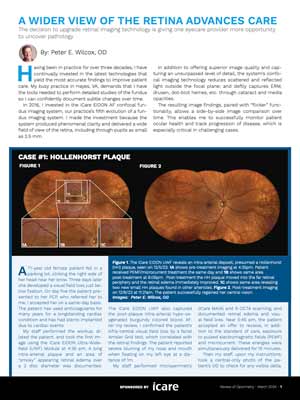Over the years that we have written The Handbook of Ocular Disease Management, we have made many dedications.
However, we have never discussed how this supplement came to be. If you ask the three of us how
The Handbook came about, you will get three different versions and perspectives. But the story has a common
theme, which is generally entertaining, involves perseverance, being in the right place at the right time, and
having people behind the scenes who had a vision regarding the potential of the project and faith in a newly
forming team.
The flashpoint for the entire idea came when we saw the first edition of The Clinical Guide to Ophthalmic Drugs, by Drs. Ron Melton and Randall Thomas. Seeing this great use of the journal supplement medium, we sought to complement their guide with one of our own that summarized the description and etiology of the most frequently encountered ocular diseases, along with abbreviated management discussions. While we thought that this was a great idea that would be embraced by the profession, publishers were far less excited. Whether it was lack of obvious funding or our “unknown” status, the pitch was received and returned with a polite but less-than-enthusiastic response. “Don’t call us… we’ll call you,” was the common reply. Since standalone monographs were rare in those days and most journals did not have formats that were conducive to the project, we abandoned the idea.
Several years later while wandering the exhibit floor at the SECO International meeting, we fortuitously ran into a then-new and young editor named Jack Persico (now Editor-in-Chief of Review of Optometry) who recognized a name on a badge, recalled the earlier pitch, introduced himself and wondered if we were still interested in doing the project. Admittedly, we had to convince ourselves that we indeed wanted to resurrect the idea. After some thought and debate, we decided that we would do one supplement encompassing the most common ocular diseases encountered in clinical practice and call it a day.
So, here we are at edition 16. Hopefully, readers find our material educational. However, few realize what goes into production of this supplement. Nobody sees the way we bicker about material that each of us edits out or material each of us tells the other to add. The way we have to prod one another from hibernation each year to begin another edition. The way that one will be told by the others that his work is all wrong. At one point or another, each of us has called it quits, with a different member of the team stepping up to mend fences. Unquestionably, production has gotten easier over time as we have perfected our system and our expectations of each other. We truly like each other, each respecting the others for the unique expertise and talents they bring to the table. We consider ourselves lucky that we get to do this and we hope it helps. We enjoy the process and thank everybody behind the curtain who takes the project from the rough draft phases to finished supplement that you are holding. We want to give our sincere gratitude to Jack Persico, for without his belief and that chance meeting, this supplement would never have happened.
The flashpoint for the entire idea came when we saw the first edition of The Clinical Guide to Ophthalmic Drugs, by Drs. Ron Melton and Randall Thomas. Seeing this great use of the journal supplement medium, we sought to complement their guide with one of our own that summarized the description and etiology of the most frequently encountered ocular diseases, along with abbreviated management discussions. While we thought that this was a great idea that would be embraced by the profession, publishers were far less excited. Whether it was lack of obvious funding or our “unknown” status, the pitch was received and returned with a polite but less-than-enthusiastic response. “Don’t call us… we’ll call you,” was the common reply. Since standalone monographs were rare in those days and most journals did not have formats that were conducive to the project, we abandoned the idea.
Several years later while wandering the exhibit floor at the SECO International meeting, we fortuitously ran into a then-new and young editor named Jack Persico (now Editor-in-Chief of Review of Optometry) who recognized a name on a badge, recalled the earlier pitch, introduced himself and wondered if we were still interested in doing the project. Admittedly, we had to convince ourselves that we indeed wanted to resurrect the idea. After some thought and debate, we decided that we would do one supplement encompassing the most common ocular diseases encountered in clinical practice and call it a day.
So, here we are at edition 16. Hopefully, readers find our material educational. However, few realize what goes into production of this supplement. Nobody sees the way we bicker about material that each of us edits out or material each of us tells the other to add. The way we have to prod one another from hibernation each year to begin another edition. The way that one will be told by the others that his work is all wrong. At one point or another, each of us has called it quits, with a different member of the team stepping up to mend fences. Unquestionably, production has gotten easier over time as we have perfected our system and our expectations of each other. We truly like each other, each respecting the others for the unique expertise and talents they bring to the table. We consider ourselves lucky that we get to do this and we hope it helps. We enjoy the process and thank everybody behind the curtain who takes the project from the rough draft phases to finished supplement that you are holding. We want to give our sincere gratitude to Jack Persico, for without his belief and that chance meeting, this supplement would never have happened.
Additional Publications
-
A Wider View Of The Retina Advances Care
The decision to upgrade retinal imaging technology is giving one eyecare provider more opportunity
to uncover pathology.Sponsored by iCare
It’s Time to Talk to Your Patients about Digital Eye Strain
New Developments in Glaucoma
Ophthalmic Product Guide - February 2024
Preservatives in Eye Care: Intrepid Eye Society Consensus Discussion
2024 Conference Planner



